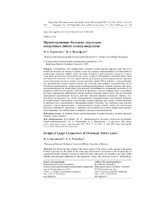| dc.contributor.author | Короткевич, М. А. | |
| dc.contributor.author | Прокофьева, Н. А. | |
| dc.coverage.spatial | Минск | ru |
| dc.date.accessioned | 2018-10-03T12:04:40Z | |
| dc.date.available | 2018-10-03T12:04:40Z | |
| dc.date.issued | 2018 | |
| dc.identifier.citation | Короткевич, М. А. Проектирование больших переходов воздушных линий электропередачи = Design of Large Connectors of Overhead Power Lines / М. А. Короткевич, Н. А. Прокофьева // Энергетика. Известия высших учебных заведений и энергетических объединений СНГ. – 2018. – № 5. – С. 432-439. | ru |
| dc.identifier.uri | https://rep.bntu.by/handle/data/47964 | |
| dc.description.abstract | Установлено, что напряжения в низших точках провеса провода или троса и в точках их подвеса на опорах в одном и том же пролете, определенные в соответствии со свойствами идеально гибкой нити (подобно которой и располагаются провода и тросы в пролете), различаются незначительно и учет разности отмеченных значений имеет лишь методическое значение. В статье представлены результаты расчета стрелы провеса провода и троса больших пролетов линии электропередачи длиной 500 м и более с использованием как традиционной теории цепной линии, так и теории цепи равного сопротивления, когда считается переменной по длине пролета площадь поперечного сечения провода или троса, пропорциональная их натяжению, при которой обеспечивается одинаковая вероятность их разрыва в любой точке пролета. При расчете проводов и тросов в нормальных и аварийных режимах определены наибольшие стрелы провеса, которые имеют место или при высшей температуре окружающего воздуха, или при нагрузке провода гололедом. Провод должен быть смонтирован так, чтобы обеспечивались нормированные допускаемые габариты до пересекаемых инженерных сооружений, водных преград или земли, устанавливаемые в зависимости от номинального напряжения линии. Отмечено, что значения стрел провеса провода и троса, определенные с использованием теории цепной линии для переходных пролетов, меньше по сравнению с данными, полученными на основе теории цепи равного сопротивления. Это необходимо учитывать в процессе проектирования. | ru |
| dc.language.iso | ru | ru |
| dc.publisher | БНТУ | ru |
| dc.title | Проектирование больших переходов воздушных линий электропередачи | ru |
| dc.title.alternative | Design of Large Connectors of Overhead Power Lines | ru |
| dc.type | Article | ru |
| dc.identifier.doi | 10.21122/1029-7448-2018-61-5-432-439 | |
| local.description.annotation | It is found that the voltage at the lowest points of the wire or cable sag and at the points of their suspension on the pillars in the same span, determined in accordance with the properties of a perfectly flexible filament (similar to which the wires and cables are located in the span), differ slightly, and taking the difference of the mentioned values into account is only of methodologycal importance. The article presents the results of the calculation of wire and cable sag of large spans of power transmission line of 500 m or more length using both the traditional theory of the catenary line and the theory of equal resistance, when the cross-sectional area of a wire or cable, proportional to their tension, is considered variable in the span length, which provides the same probability of breaking them at any point of the span. When calculating the wires and cables in normal and emergency conditions, the largest sags are determined, which take place either at
a higher ambient temperature or at a load of the wire with ice. The wire must be mounted in such a way as to ensure the normalized permissible dimensions to crossed engineering structures, water barriers or land, that are determined depending on the nominal voltage of the line. It is noted that the values of the wire and cable sags determined using the theory of the catenary line for the transition spans are less (although slightly) as compared to the data obtained on the basis of the theory of the equal resistance circuit. This must be taken into account in the design process. | ru |

